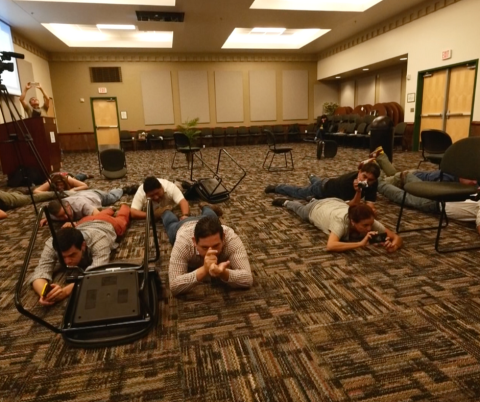
Journalists and citizens alike need to be prepared to face the unexpected, including getting caught in the middle of gunfire, as has happened in recent attacks in Rio de Janeiro, Paris, Baghdad, San Bernardino, Orlando and Dallas.
This is why I’ve developed and now use a battlefield simulator for journalist security trainings at the U.S.-Mexico border, as part of my work as an ICFJ Knight Fellow.
The simulator contains audio taken from actual battles between drug traffickers and military units in Mexico. Journalists are trained to take cover while they hear the actual sounds of a gun battle. This audio creates a dramatic environment and, from what I’ve seen, reporters appreciate having the chance to practice taking cover.
Border journalists understand the need for this type of training very well. TV reporter Miguel Turriza is one of them. On Feb. 19, 2009, he was caught in the crossfire between drug traffickers and the Mexican military in Reynosa, a city at the border with Texas. Turriza recorded the incident and uploaded it to YouTube, where it has received more than 4.7 million views.
On that cloudy morning, he and his cameraman arrived at the scene about 20 minutes after the exchange of gunfire, believing it was over.
Grabbing a microphone with one hand and gesturing with the other, Turriza spoke into the camera: “A few moments ago, a shooting happened on this street of Reynosa. High-caliber weapons were used and traffic was stopped.” A few seconds later, while the camera was still running, the gunfight started again. By instinct, both men crouched down until they lay on the ground.
Carlos Alberto Guajardo, a print journalist from Matamoros, another border city, was not that lucky. In November 2010, he attempted to get closer to an armed confrontation in his pickup truck, but Mexican soldiers mistook him for a gunman and killed him.
More than 250 journalists have died in crossfire or combat since 1992, according to the Committee to Protect Journalists. Now, with terrorist incidents in Europe and mass shootings in the U.S., journalists may find themselves in a crossfire situation in any urban environment, either in the U.S. or abroad. U.S. journalists also need to know how to protect themselves while covering domestic unrest in the United States, as was recently seen with protests in Milwaukee.
With this in mind, I am leading a series of security workshops for journalists who cover the U.S.-Mexico border as part of my ICFJ Knight International Journalism Fellowship. The training includes use of the battlefield simulator, so that participants may learn the different positions for crouching down and hiding to protect their bodies from gunshots. Bernardo Gómez, a former Mexican federal police officer, trains journalists in the art of taking cover from gunfire.
I hope that no journalists are ever caught again in the middle of a gunfight, but if it happens, training in the simulator might help them survive and get back to the office to file their story.
Battlefield simulator from Jorge Luis Sierra on Vimeo.
Main image courtesy of Jorge Luis Sierra.
This post was also published on IJNet, which is produced by ICFJ.